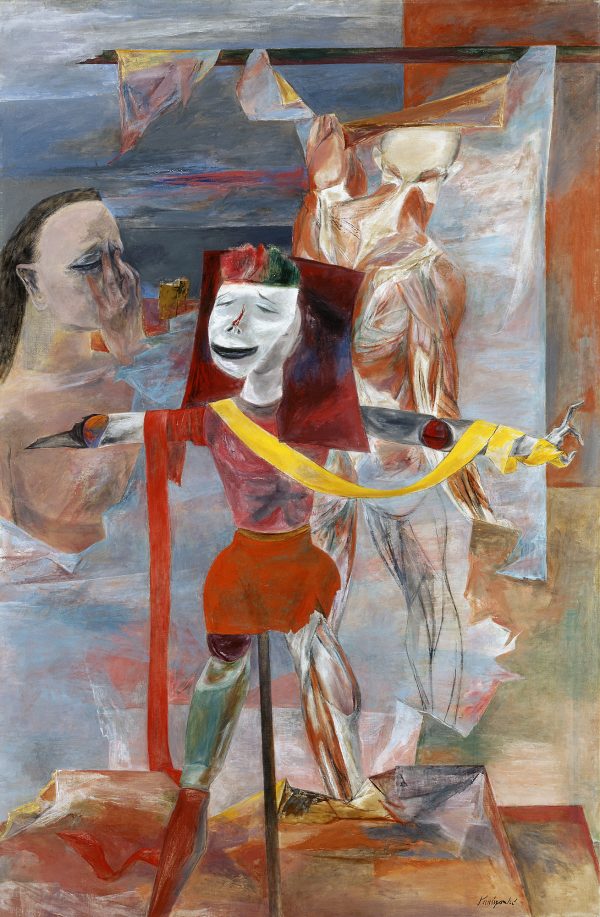
Revelation
Kuniyoshi, Yasuo
1949
Artwork Information
-
Title:
Revelation
-
Artist:
Kuniyoshi, Yasuo
-
Artist Bio:
American (born in Japan), 1889–1953
-
Date:
1949
-
Medium:
Oil and graphite on canvas
-
Dimensions:
70 1/8 x 46 3/8 in.
-
Credit Line:
Wichita Art Museum, Roland P. Murdock Collection
-
Object Number:
M80.49
-
Display:
Not Currently on Display
About the Artwork
In Yasuo Kuniyoshi’s Revelation, transparent layers of paint combine with a fractured composition of disturbing figures to amplify the shifting space of an image that is theatrical, even shocking. Tension arises when a superficially cheerful palette is used to picture strange figures of uncertain, perhaps sinister, meaning. None of these figures interact; they do not even represent living humans. The female form on the left is a ghostly half-figure, grimacing and contorted. The torn anatomical chart at the right is a studio prop. So, too, is the lifeless wooden mannequin that replaces the sensual women of Kuniyoshi’s earlier works. This broken mannequin is arranged like a crucifix, central and iconic in the composition, yet precariously balanced and disquieting.
The smiling mask worn by this central figure is a particularly enigmatic motif. The use of masks in many of Kuniyoshi’s late paintings is intriguing: Was the artist being playful or was he hiding something? The mask in Revelation may be a Japanese Noh theater mask, given to Kuniyoshi by his student, Paul Jenkins.1 The inclusion of this Japanese artifact in the picture may represent the interrelationship between Kuniyoshi s ethnicity and contemporary American society. This was the age of nationalism and anti-communism that followed World War II and escalated during the McCarthy era. Foreign-born individuals, as well as political liberals, often were suspected of being “un-American” and were targeted for investigation by government committees. The environment of fear and concealment that pervaded American life was symbolized through Kuniyoshi’s inclusion of masks in works like Revelation.
Kuniyoshi had a long history of involvement with leftist political groups. He was on the executive committee of the American Artists Congress from 1937-40, was president of An American Group from 1939-44, and was the first president of Artists Equity from 1947-50. His paintings in the controversial Advancing American Art exhibition, organized by the U.S. State Department in 1946, were widely criticized in the American press, and Kuniyoshi was labeled a communist. However, Kuniyoshi was widely accepted by his peers and museum curators as a leader in modern American painting. He was one of four painters to represent the United States at the 26th Venice Biennale in 1952, and Revelation was included in the Landmarks in American Art exhibition in 1953.2
Kuniyoshi’s works invite multiple interpretations. His colleague and friend Ben Shahn wrote that Kuniyoshi’s paintings had “a certain quality—I suppose you would call it metaphoric, an extended and beyond meaning, never spelled out, always elusive, but inviting the observer of a picture to wonder, so no picture is ever a closed statement, a finality, but is rather a haunting and undisclosed world in itself.”3 Ultimately, the “revelation” can only occur through the interaction between the viewer and the painting.
1. Paul Jenkins, in Yasuo Kuniyoshi, 1889-1953: A Retrospective Exhibition (Austin, Tex.: University Art Museum, 1975), 47.
2. Landmarks in American Art, 1670-1950 (New York: Wildenstein and Company, 1953), ill. no. 61.
3. Ben Shahn, foreword to Yasuo Kuniyoshi: Retrospective Exhibition (Boston: Boston University Art Gallery, 1961), n.p.